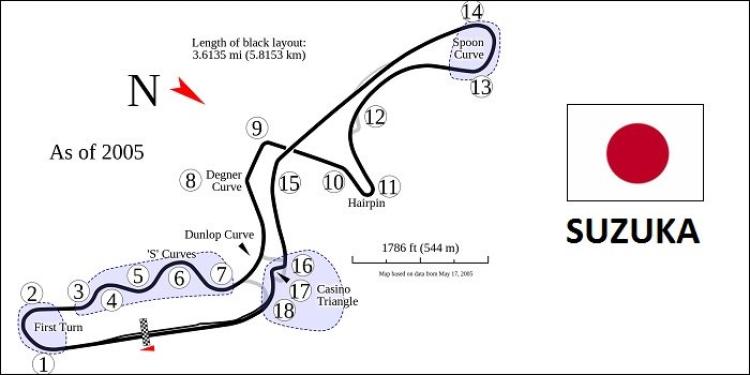Suzuka Circuit Lap with GamingZion
Posted: September 24, 2015
Updated: June 29, 2023

The Suzuka Circuit lap is the highlight of the racing calendar for Formula 1 drivers.
Formula 1 returns to the Suzuka Curcuit for the Japanese Grand Prix. The first thought that will pop into everyone’s mind is that this is the venue where the last fatal F1 accident happened. Jules Bianchi’s crash occurred in the 2014 Japanese GP. He hit a recovery vehicle in wet conditions and suffered serious head injuries. He died nine months later.
• Japanese GP the most challenging in F1
• Suzuka Circuit tricky for drivers and engineers
• Safety has been always a concern
Despite the sad events, the Suzuka Circuit lap is still one of the drivers’ favorite rides. The track layout poses a complex challenge towards both drivers and engineers. Moreover it is thrilling to race through its vast selection of raw corners and exciting combinations that sometimes trick even the best Formula 1 drivers. And all who bet on sports in Japan, also have a soft spot for it.
Suzuka Circuit basic information
Suzuka is located in Mie Prefecture, Japan, 300 kilometres (185 miles) from Tokyo and 50 kilometres (30 miles) from Nagoya. The Suzuka Circuit was designed by Dutch engineer John Hugenholtz and originally built as a Honda test track in 1962. Soichiro Honda wanted a circuit with all types of corners and long straights. The point was to create a perfect venue for testing, but the result of the work was a legendary Formula One circuit.
The Suzuka circuit lap is 5.807 kilometres (3.608 miles) long. The Japanese Grand Prix consists 53 laps, which equals 307.5 kilometres (191.1 miles). The track has 17 corners, of which 10 are right-hand and 7 are left-hand turns. Suzuka joined the Formula One calendar in 1987. There were two F1 Grands Prix held in the country in the seventies, but those were hosted by the Fuji Speedway like the 2007 and 2008 Japanese Grands Prix.
Main characteristics of the Suzuka Circuit lap
This is a very challenging racetrack, where the idea of the perfect lap is virtually nonexistent. A typical feature of a Suzuka circuit lap is the rollercoaster-like feeling as the racetrack has craggy curves and terrain changes as well. It features all types of corners and two long straights. This is the only F1 circuit in the current racing calendar that has a figure-8 layout with a tunnel and a bridge marking out section limits.
Because of the large number of medium speed corners and the big portion of full-throttle sections, engineers have to make a compromise when the car setup is being calibrated. Maximum speed is around 320 km/h, while the average speed on a Suzuka circuit lap is roughly 220 km/h. A certain amount of downforce is needed for smooth cornering, but if the car is stuck to the asphalt too much, it will be slow in the speedy parts of the track. That’s why a reasonable compromise is to be calculated as there is no perfect setup for the Suzuka Circuit.
The Suzuka Circuit was considered as a very dangerous track until the eighties. Fatal accidents were a recurring feature of the racing course and therefore security developments were carried out regularly. These works did not really affect the layout however, as only a few corners were adjusted. The developments were mainly limited to widening the run-off areas. Suzuka is now a much safer venue, but sadly, fatal accidents happen from time to time.
130R
The maximum G-force the drivers experience during a Suzuka circuit lap is 4.0 G. This affects them in the legendary 130R corner (number 15), which is the most exciting moment of the lap for the racers and even for those mobile betting players who hit the track in racing simulators. This is a full-speed, long left-hander. Its radius was originally 130 meters, therefore the name. However, the track was revised when safety concerns occurred after the Allan McNish horror crash in 2002, which the British driver fortunately escaped without serious injuries.
The 130R was restructured into a double-apex turn and the drivers can corner it with full throttle since. Unfortunately a tragedy followed this redesign, as MotoGP rider Daijiro Kato suffered a fatal injury here in the 2003 Grand Prix of Japan. The shape of the section left unchanged and there were no serious accidents in this curve since.
A lap in Suzuka
The start/finish straight is on a downward slope. From here, drivers turn round in corner 1 and 2 towards the Esses (3-6). This section is one of the drivers favorites. It resembles to the sand dunes of the Zandvoort circuit, the track that the Suzuka designer, Hugenholtz was managing when started to work on the Japanese circuit.
The Esses is a very tricky section. Here the smallest mistake would ruin the whole lap of the drivers. And the possibility for an error is always there, since the compromise in car setup means that the drivers will never have perfect grip in this section.
The Esses are followed by the Dunlop corner, where Jules Bianchi got fatally injured in 2014. Originally this is not a very dangerous curve, but the circumstances were extremely unlucky in the 2014 Japanese Grand Prix with the heavy rain, the limited visibility and the crane on the side of the track…
After Dunlop, the Degner curves (8-9) are the next turns – originally one corner, but later was broke into two separate bends for safety reasons. Then, after going through the tunnel, we are already in section two. Apart from the Hairpin (11) and the Spoon Curve (13-14), this is a very fast part of the Suzuka Circuit lap.
The 130R is just between two straights, and the Casino Triangle (16-18) is the last combination of this very demanding Suzuka Circuit lap. According to Fernando Alonso, the Suzuka Circuit is the hardest and most challenging racetrack of the world. Rumor has it that Sebastian Vettel once said that this racing course was designed by God himself…
Japanese GP odds and chances
Usually and not surprisingly, teams with the best all-round package have the best chances to win the Formula 1 Japanese Grand Prix. Sophisticated aero solutions are needed for the first part of the track, while engine power contributes greatly in the second part.
Fans of Formula One love this tricky venue, because driver skills are also a more important factor than at most tracks in the Grand Prix calendar. In the last twenty-five years it was a rarity that such a driver was able to win the Japanese GP, who finished his racing career without a world championship title.
Bet365 always has a vast selection of Formula One odds, so if you plan to bet on the Japanese Grand Prix, it is worthwhile to have a look at their offerings. Also check our Bet365 Sportsbook review to find out more about the top online bettingoperator!












